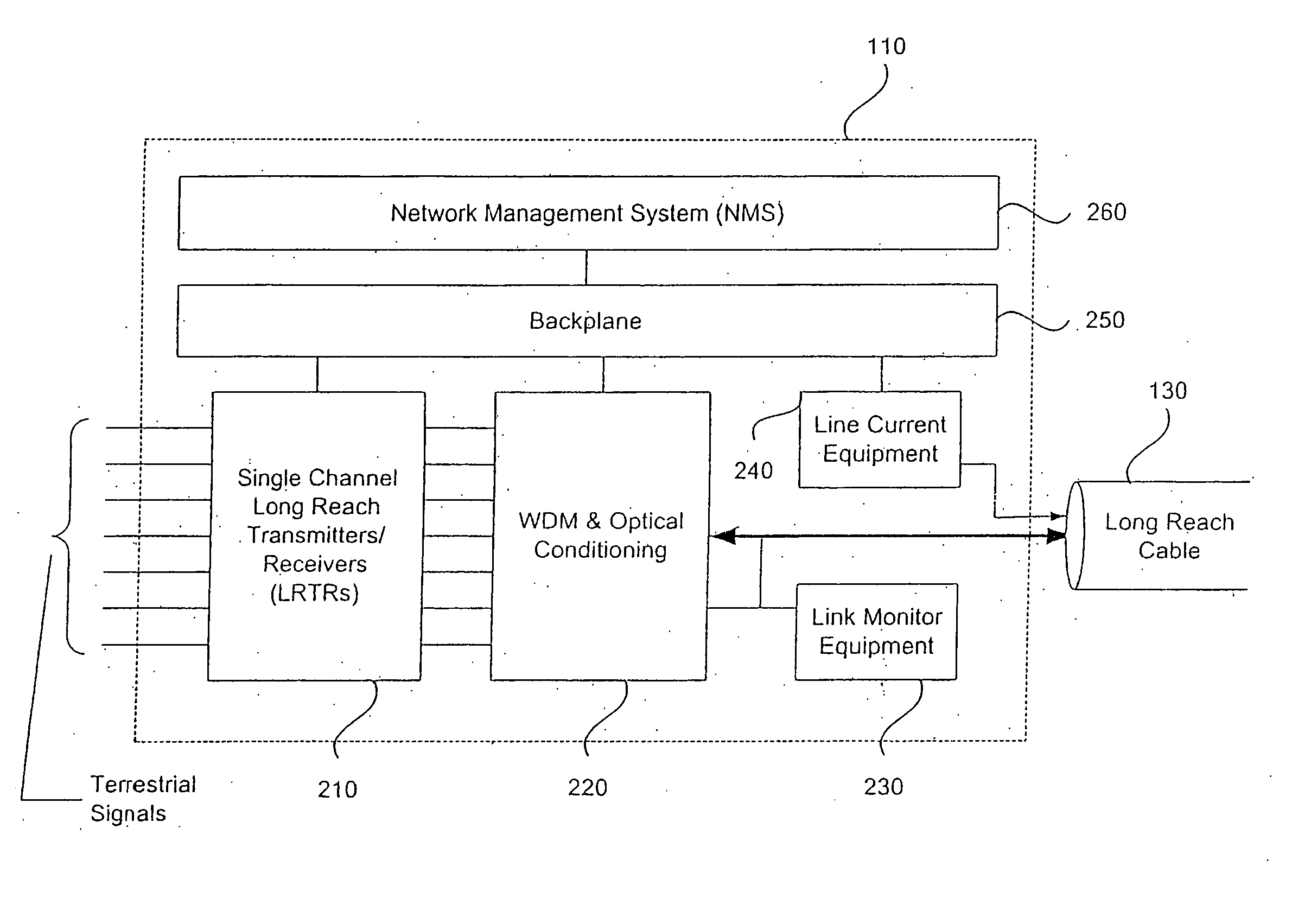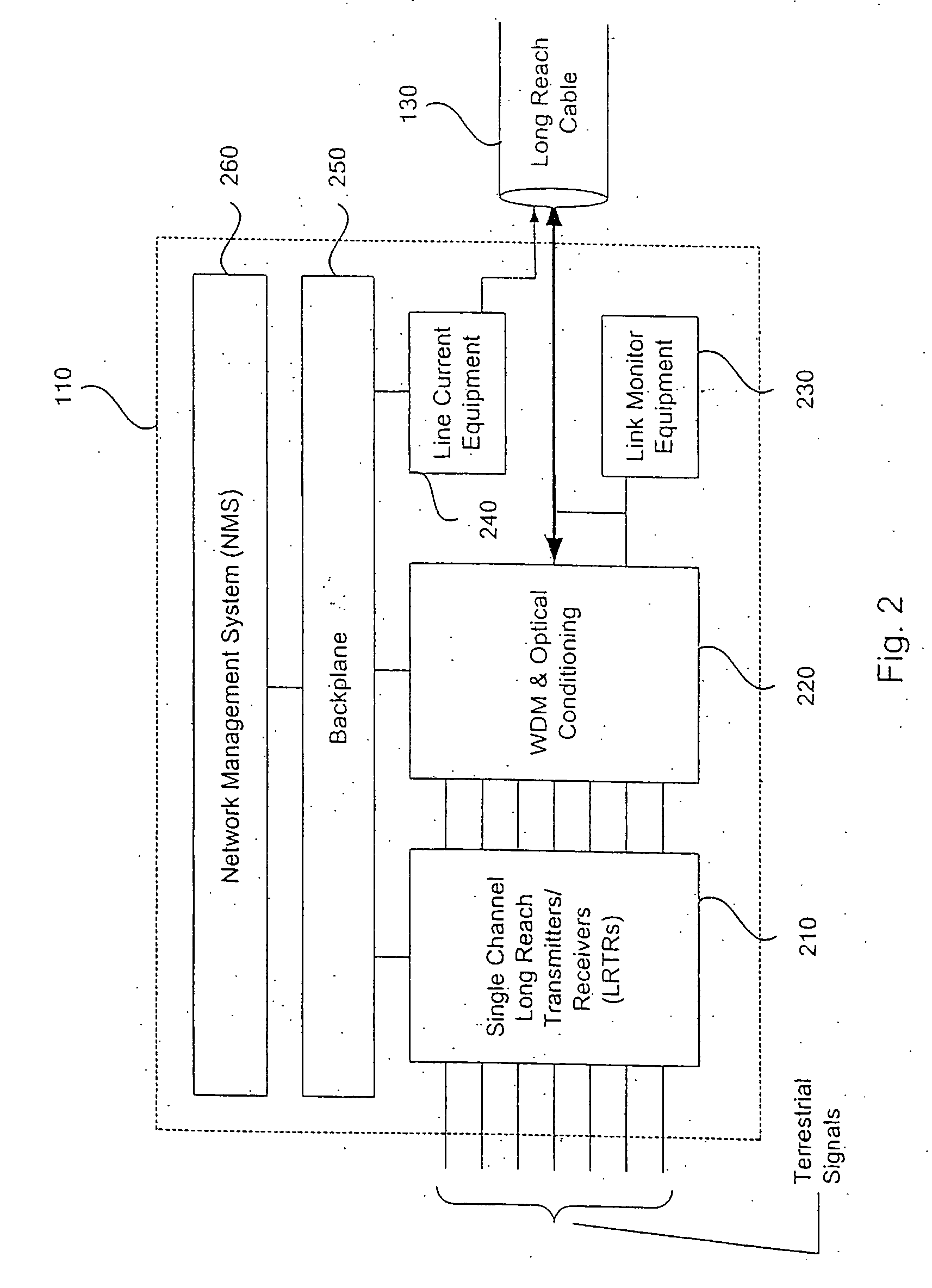Interconnections and protection between optical communications networks
a technology of optical communication network and interconnection, applied in the direction of optics, electrical appliances, instruments, etc., can solve the problems of damage or cutting of existing lines, affecting the service life of existing lines, and unable to commercially realize the retrofitting of existing cable landing sites to handle new equipmen
- Summary
- Abstract
- Description
- Claims
- Application Information
AI Technical Summary
Benefits of technology
Problems solved by technology
Method used
Image
Examples
first embodiment
[0106] In more detail, for a branch unit which utilizes a passive combiner, when the service path is not operating normally, as detected by a detector provided at the output of the combiner (see FIG. 17, for example), then the last few pump amplifiers of the line units in the protection path are set to provide a normal power output (somewhere between minimum and maximum power output capability), to provide the backup signal to the combiner to make up for the system problem in the service path.
[0107] The first and second branch paths meet each other at a branch unit to form the beginning portion of the main optical path. Referring to FIG. 17, which shows a first embodiment of the invention, the branch unit 1700 includes a combiner 1710, which is preferably a 2×1 passive combiner. The combiner combines the signals received on the first and second optical branch paths and outputs the combined signal onto the main optical path.
[0108] A detector, which is shown as a photodiode 1720, is...
third embodiment
[0155] a fiber optic system is shown by the block diagram of FIG. 24. The branch unit 2400 comprises two 2×2 switches 2420 and 2410. Service receive optical fiber 2260 is optically connected to a first input of a first 2×2 switch 2410. Protect receive optical fiber 2270 is optically connected to a second input of a first 2×2 switch 2410. A first output of the first 2×2 switch 2410 is optically connected to a first input of a second 2×2 switch 2420. A second output of the first 2×2 switch 2410 is optically connected to a second input of a second 2×2 switch 2420.
[0156] In the third embodiment, under normal operating conditions, identical service and protection signals are received via optical fibers 2260 and 2270, albeit on different input ports, of the first 2×2 switch 2410. Thus, the first 2×2 switch 2410 receives, on its first input port, the primary or service information signals sent on the first branch path 2260. The first 2×2 switch 2410 also receives, on its second input port,...
fourth embodiment
[0165] Referring now to FIG. 24, which shows a configuration that may be utilized for one WDM signal of NPE 2540 if the service line for that WDM signal is non-operative, then the output of the 2×2 switch 2420 would indicate no signal present, as detected by photodiode 2440. This information is provided to processor 2430, which provides control signals to switches 2420, 2410 to provide the protection line for that WDM signal to the output of switch 2420.
[0166] Similarly, a structure as shown in FIG. 22 or in FIG. 23 may be utilized for each of the WDM signals of NPE 2540 according to the fourth embodiment.
[0167] As an alternative configuration of the fourth embodiment, one photodiode may be utilized for more than one WDM signal, whereby outputs from a plurality of switches are provided to one photodiode, whereby a light tap from each of those switches is provided to the one photodiode. With this configuration, the photodiode can detect a problem in a group of WDM signals, which ma...
PUM
 Login to View More
Login to View More Abstract
Description
Claims
Application Information
 Login to View More
Login to View More - R&D
- Intellectual Property
- Life Sciences
- Materials
- Tech Scout
- Unparalleled Data Quality
- Higher Quality Content
- 60% Fewer Hallucinations
Browse by: Latest US Patents, China's latest patents, Technical Efficacy Thesaurus, Application Domain, Technology Topic, Popular Technical Reports.
© 2025 PatSnap. All rights reserved.Legal|Privacy policy|Modern Slavery Act Transparency Statement|Sitemap|About US| Contact US: help@patsnap.com



